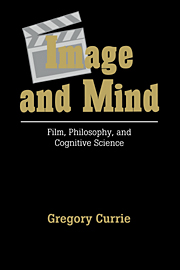Book contents
- Frontmatter
- Contents
- Preface
- Acknowledgements
- Film, 1895–1995
- Image and mind
- Introduction: the essence of cinema
- Part I Representation in film
- Chapter 1 The myth of illusion
- Chapter 2 The imprint of nature
- Chapter 3 Realism
- Chapter 4 Languages of art and languages of film
- Part II Imagination
- Part III Interpretation
- In conclusion
- Named propositions
- Bibliography
- Index
Chapter 3 - Realism
Published online by Cambridge University Press: 28 October 2009
- Frontmatter
- Contents
- Preface
- Acknowledgements
- Film, 1895–1995
- Image and mind
- Introduction: the essence of cinema
- Part I Representation in film
- Chapter 1 The myth of illusion
- Chapter 2 The imprint of nature
- Chapter 3 Realism
- Chapter 4 Languages of art and languages of film
- Part II Imagination
- Part III Interpretation
- In conclusion
- Named propositions
- Bibliography
- Index
Summary
The guiding myth, then, inspiring the invention of cinema, is … a re-creation of the world in its own image.
André BazinIn Chapter 1, I distinguished three theses about cinema: Illusionism, Transparency and Likeness. I have been hard on the first two. In this chapter I want to defend the thesis of Likeness, which has been under attack for a while now from those who reject the notion of likeness or resemblance between images and the things they are images of, and who stress the artifice, the conventionality, the “codedness” of cinema. This is one aspect of their rejection of film realism. I, on the other hand, hold that Likeness is a defensible version of film realism. I also want to defend the claim that there are styles of film making which are especially realistic in the sense explicated by Likeness: long-take, deep-focus style is a notable example. But I want to avoid a misunderstanding. My defence of Likeness is metaphysical, not aesthetic. I am not advocating that film makers adopt styles which, like long-take, deep-focus style, attempt to exploit the possibilities for realism in film. I am arguing that Likeness is a coherent thesis, and that it is possible to achieve a considerable degree of this kind of realism in film. Whether you think that is a worthwhile project is another matter.
First I shall offer a general theory of pictorial representation, or depiction, according to which depictions are like the things they depict.
- Type
- Chapter
- Information
- Image and MindFilm, Philosophy and Cognitive Science, pp. 79 - 112Publisher: Cambridge University PressPrint publication year: 1995



